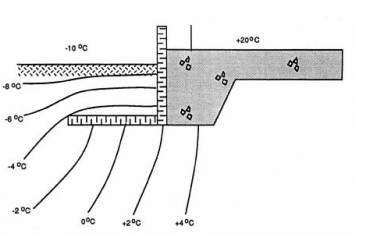
canadiancontractor
Code changes that could save thousands Part 2: The need for innovation: slab on grade
Why do we build foundations a minimum of 4 feet below grade in Canada?

By Paul Duffy, M.A.Sc., P. Eng.
Last issue, Duffy pointed out why the regulatory industry makes innovation so expensive. In this issue, he uses the real-world example of Slab on Grade construction to illustrate the roadblocks to innovation and how they create real world problems.
There are many factors driving the need for innovation, ranging from energy and environmental imperatives to limits on raw material resources, or simply finding more effective ways to build, reduce cost or improve affordability, etc. We have all seen the workings from researchers, policy analysts, lobbyists and the like. To continue building without new systems and technology advances is nothing short of crazy.
To illustrate the point, it really takes a couple of examples.
Slab on Grade Construction
Firstly, consider slab-on-grade construction. Why do we build foundations a minimum of 4 feet below grade in Canada? The answer is simple—to get footings below the frost line. But, what if you insulate the footings so that frost does not penetrate the ground, how far down do you need to go? Well the Code does not tell you.
No big deal… you have to go down four feet, so insulate the walls and turn the basement into living space. It’s not the best solution—moisture ingress can be an issue and the view underground is less than ideal, but, creating living spaces below grade does kind of turn a lemon into lemonade, as the expression goes.
But wait, suppose you are building a home for seniors, or someone who has mobility problems. You don’t want a house with stairs. You can add an elevator, I suppose, with all the associated costs. Or, you can simply build a slab-on-grade house. But that is not described in the Code particularly well, so you will need to hire an engineer, and because the Code doesn’t help much, be prepared for delays getting a building permit because most municipalities will balk at a house that does not have a basement or at least perimeter footings that go below the “frost line”.
Not convinced that this is important to you? Slab-on-grade houses are not common in this part of the world so is it a real issue or am I just making a mountain out of a molehill? How about building a house near a lake or river… chances are you will hit the water table close to the surface of the land… do you really want to go down 4 feet to avoid frost? Do you want to drain the lake? I have seen lots of folks try to solve the problem by moving in soil, sometimes hundreds of cubic meters of soil to raise the grade and protect their foundation. You can easily see lots of situations where tens of thousands of dollars are added to the cost of a construction project because the builder needs to place footing below the frost line. Does that sound more sensible than a slab-on-grade foundation?
Still not convinced? Maybe you simply want a basement walk-out at the rear of the home. If there was a simple solution that could save you thousands of dollars, wouldn’t you want to hear about it or at least have that option?
The interesting thing is that most of the world builds without basements. Yes, it is true that you don’t need to go down below the frost line in places like Florida or Texas so the way they build might not necessarily work in Canada. But consider the way they build in places like Sweden. Swedes often build with insulated slab-on-grade construction and they have done so for years. Here is the crazy part…their Code was based on research partly done right here in Canada! In the 1960’s, a Professor by the name of Fred DeLory at the University of Toronto did pioneering research into insulated slab-on-grade construction and his work made its way into Nordic Building Codes, but the Codes for foundation design right here in Canada never did change. It’s hard to say whether we should be proud or embarrassed.
It’s a pretty important (and ironic) gap in our Codes but is it the only area where we are lagging? Sadly, no it is not.
To read part 1 of this series, go here. Next issue: Roof venting
Questions and comments on this article can be addressed to Paul Duffy and Associates Inc.
pduffy@jpaduffy.com